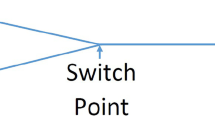Abstract
We address the problem of generating detailed conflict-free railway schedules for given sets of train lines and frequencies. To solve this problem for large railway networks, we propose a network decomposition into condensation and compensation zones. Condensation zones contain main station areas, where capacity is limited and trains are required to travel with maximum speed. They are connected by compensation zones, where traffic is less dense and time reserves can be introduced for increasing stability. In this paper, we focus on the scheduling problem in condensation zones. To gain structure in the schedule we enforce a time discretisation which reduces the problem size considerably and also the cognitive load of the dispatchers. The problem is formulated as an independent set problem in a conflict graph, which is then solved using a fixed-point iteration heuristic. Results show that even large-scale problems with dense timetables and large topologies can be solved quickly.









Similar content being viewed by others
References
Bourachot J (1986) Computer-aided planning of traffic in large stations by means of the AFAIG model. Rail Int 2–18
Burkard M (2000) A continuous relaxation based heuristic for a class of constrained semi-assignment problems. Ph.D. thesis, ETH Zurich
Caimi G, Herrmann T, Burkolter D (2005) Findind delay-tolerant train routing through stations. In: Fleuren H, den Hertog D, Kort P (ed) Operations research proceedings 2004. Springer, Heidelberg, pp 136–143
Carey M (1994) A model and strategy for train pathing with choice of lines, platforms, and routes. Trans Res Part B 28(5):333–353
Carey M, Carville S (2003) Scheduling and platforming trains at busy complex stations. Trans Res Part A 37:195–224
Cochand M (1993) A fixed point operator for the generalised maximum satisfiability problem. Discrete Appl Math 46(2):117–132
Herrmann T (2005) Train routings through station areas and stability of timetables. Ph.D. thesis, ETH Zurich
Huisman D, Kroon L, Lentink R, Vromans M (2005) Operations research in passenger railway transportation. In: Statistica Neerlandica., vol 59, no 4. Erasmus Research Institute Of Management (ERIM), pp 467–497. http://ideas.repec.org/p/dgr/eureri/30002129.html
Kroon LG, Zwaneveld PJ (1995) Stations: final report of phase 1. Technical report 201, Rotterdam School of Management
Kroon L, Dekker R, Vromans M (2005) Cyclic railway timetabling: a stochastic optimization approach. In: ERIM report series research in management, no ERS-2005-051-LIS. Erasmus Research Institute of Management (ERIM), RSM Erasmus University. http://hdl.handle.net/1765/6957
Laube F, Mahadevan V (2008) Bringing customer focus into every nut and bolt of the railway: Swiss Federal Railway’s path into the future. In: Proceedings of the 8th World Congress of Railway Research (WCRR). Seoul, Korea
Laube F, Roos S, Wüst R, Lüthi M, Weidmann U (2007) PULS 90 - ein systemumfassender Ansatz zur Leistungssteigerung von Eisenbahnnetzen. Eisenbahntech Rundsch 3:104–107 (in German)
Liebchen C (2006) Periodic timetable optimization in public transport. Ph.D. thesis, Technical University Berlin
Lüthi M, Nash A, Weidmann U, Laube F, Wüst R (2007) Increasing railway capacity and reliability through integrated real-time rescheduling. In: Proceedings of the 11th world conference on transport research. Berkeley
Odijk M (1996) A constraint generation algorithm for the construction of periodic railway timetables. Trans Res Part B 30(6):455–464
Pachl J (2002) Railway operation and control. VTD Rail, Mountlake Terrace. ISBN 0-9719915-1-0
Roos S (2006) Bewertung von Knotenmanagement-Methoden für Eisenbahnen. Master’s thesis, Institute for Transport Planning and Systems, ETH Zurich (in German)
Schrijver A, Steenbeck A (1994) Dienstregelingontwikkeling voor Railned (timetable construction for Railned). Technical report, C.W.I. Center for Mathematics and Computer Science, Amsterdam (in Dutch)
Serafini P, Ukovich W (1989) A mathematical model for periodic scheduling problems. SIAM J Discrete Math 2(4):550–581
Zwaneveld PJ (1997) Railway planning—routing of trains and allocation of passenger lines. Ph.D. thesis, Erasmus University Rotterdam
Zwaneveld P, Kroon L, van Hoesel S (2001) Routing trains through a railway station based on a node packing model. Eur J Oper Res 128(1):14–33(20)
Zwaneveld PJ, Kroon LG, Romeijn HE, Salomon M,. Dauzère-Pérès M, Van Hoesel SPM, Ambergen HW (1996) Routing trains through railway stations: model formulation and algorithms. Transp Sci 30(3):181–194
Acknowledgements
We thank the Swiss Federal Railways, Infrastructure Division for funding and providing data and in particular Dr. Felix Laube, Samuel Roos, Oskar Stalder, and Dr. Raimond Wüst for insightful discussions. Furthermore, we thank the referees for their constructive comments that helped improving the quality of this paper.
Author information
Authors and Affiliations
Corresponding author
Rights and permissions
About this article
Cite this article
Caimi, G., Burkolter, D., Herrmann, T. et al. Design of a Railway Scheduling Model for Dense Services. Netw Spat Econ 9, 25–46 (2009). https://doi.org/10.1007/s11067-008-9091-6
Published:
Issue Date:
DOI: https://doi.org/10.1007/s11067-008-9091-6




